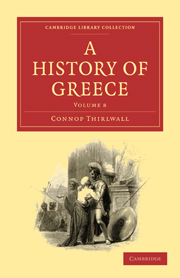Book contents
- Frontmatter
- Contents
- ERRATA
- CHAPTER LX FROM THE BATTLE OF IPSUS TO THE DEATH OF PYRRHUS
- CHAP. LXI FROM THE DEATH OF FYRRHUS TO THE ACCESSION OF ANTIGONUS DOSON
- CHAP. LXII FROM THE ACCESSION OF ANTIGONUS DOSON TO THE BATTLE OF SELLASIA
- CHAP. LXIII FROM THE BATTLE OF SELLASIA TO THE END OF THE SOCIAL WAR BETWEEN THE ACHÆANS AND ÆTOLIANS
- CHAP. LXIV FROM THE END OF THE SOCIAL WAR BETWEEN THE ÆTOLIANS AND THE ACHÆANS TO THE PROCLAMATION OF THE LIBERTY OF GREECE UNDER ROMAN PROTECTION
- CHAP. LXV FROM THE PROCLAMATION OF THE LIBERTY OF GREECE UNDER ROMAN PROTECTION TO THE EMBASSY OF CALLICRATES TO ROME
- CHAP. LXVI FROM THE EMBASSY OF CALLICRATES TO ROME TO THE REDUCTION OF GREECE INTO A ROMAN PROVINCE
- INDEX
CHAP. LXIV - FROM THE END OF THE SOCIAL WAR BETWEEN THE ÆTOLIANS AND THE ACHÆANS TO THE PROCLAMATION OF THE LIBERTY OF GREECE UNDER ROMAN PROTECTION
Published online by Cambridge University Press: 05 July 2011
- Frontmatter
- Contents
- ERRATA
- CHAPTER LX FROM THE BATTLE OF IPSUS TO THE DEATH OF PYRRHUS
- CHAP. LXI FROM THE DEATH OF FYRRHUS TO THE ACCESSION OF ANTIGONUS DOSON
- CHAP. LXII FROM THE ACCESSION OF ANTIGONUS DOSON TO THE BATTLE OF SELLASIA
- CHAP. LXIII FROM THE BATTLE OF SELLASIA TO THE END OF THE SOCIAL WAR BETWEEN THE ACHÆANS AND ÆTOLIANS
- CHAP. LXIV FROM THE END OF THE SOCIAL WAR BETWEEN THE ÆTOLIANS AND THE ACHÆANS TO THE PROCLAMATION OF THE LIBERTY OF GREECE UNDER ROMAN PROTECTION
- CHAP. LXV FROM THE PROCLAMATION OF THE LIBERTY OF GREECE UNDER ROMAN PROTECTION TO THE EMBASSY OF CALLICRATES TO ROME
- CHAP. LXVI FROM THE EMBASSY OF CALLICRATES TO ROME TO THE REDUCTION OF GREECE INTO A ROMAN PROVINCE
- INDEX
Summary
Greece was now permitted to enjoy another short interval of repose, while Philip returned to Macedonia, where his presence was needed to protect his north-west frontier against the inroads of Scerdilaidas. He was fully occupied in this quarter during the rest of the summer of 217, and in the ensuing winter he increased his navy with 200 new galleys built on the Illyrian model. In the spring he embarked his forces, and sailed round Peloponnesus into the Adriatic. Though Italy was uppermost in his thoughts, so as to haunt his dreams, he thought it necessary, before he crossed the channel, to secure his dominions more effectually against Scerdilaidas, and for this purpose resolved to make an expedition to the coast of Illyria. He expected, it seems, that the Romans would send succours to Scerdilaidas, as in fact the Illyrian, when he heard of Philip's maritime preparations, had requested them to do; and he therefore waited for some time between Cephallenia and Leucas, to ascertain the movements of the Roman fleet. But having learnt that it was still at Lilybæum, he sailed up toward Apollonia, and had anchored near the mouth of the Aous, when he received advice that Roman galleys had been seen at Rhegium bound for Apollonia. Believing that the whole Roman fleet was at hand, he gave immediate orders for retreat, and, as if chased by a victorious enemy, pushed forward day and night until he reached Cephallenia.
- Type
- Chapter
- Information
- A History of Greece , pp. 253 - 320Publisher: Cambridge University PressPrint publication year: 2010First published in: 1844



